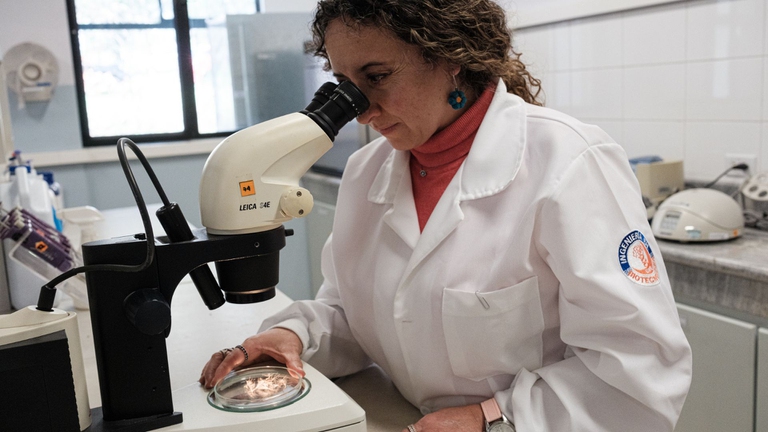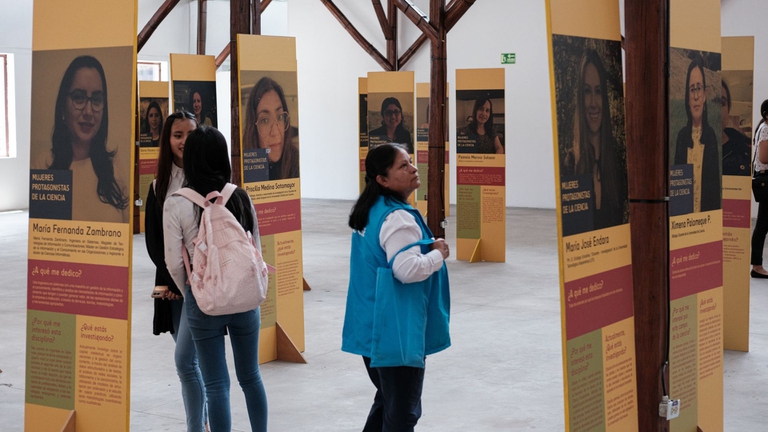
Meet Gokul Subedi and Prakriti Mainali, the founders of two humanitarian organisations with one shared goal: to improve the lives of the most vulnerable and disadvantaged members of Nepalese society.
A new travelling exhibition, which is being shown in various parts of the Andean country Ecuador, seeks to make the important work of Ecuadorian women scientists visible. Because women need science and science needs women.
It seems simple. We are half of the population. Half of the researchers should be women, half of the people in positions of power should be female. But it is far from the reality. Unfortunately. As a result, we see how scientific research is based on the male gender and women’s issues are rarely researched. Only ten years ago the first female crash test doll for car accidents was developed. Before that it was only men.
Didn’t women drive or were passengers in cars before that? And research on the consequences of using feminine hygiene is very scarce. Although it is of relevance for fifty per cent of the population every month for a large part of our lives.
Sofia Cabrera and Claudia Segovia laugh and hug. We are at the Interactive museum of Science (Museo Interactivo de la Ciencia, Mic), in Quito, the capital of Ecuador. The achievement to which the scientists refer is the opening of “Women protagonists in Science”, a travelling exhibition on Ecuadorian and Ecuador-based women scientists that seeks to motivate the participation of women and girls in academia and research.
It contains profiles and testimonies of 102 women researchers and has been developed by the museum, the Ecuadorian network of women scientists, Remci, and the organisation of Ibero-American States, Oie. So far, some twenty thousand people have seen the exhibition which has been shown in various locations in the Ecuadorian cities of Cuenca, Guayaquil, and Quito.
Both Sofia and Claudia are part of Remci, Claudia is the coordinator. The network has existed for seven years and has around four hundred members in the country.
“We want to show that there are women in science in Ecuador. It is important, not only to make it visible but also to inspire girls to get involved in science.”
Claudia Segovia is the coordinator and co-founder of Remci and she is wearing a giant smile on this day. “It’s a super exciting moment, here we are! We started with 22 women – now we are 102,” she says. For the start of the exhibition, which just happened to coincide with the pandemic in 2020, profiles of some 22 women scientists had been prepared. But as time has gone by and the exhibition has been shown in various locations, more and more testimonies of women scientists have been added.
“A girl can’t be or dream anything she can’t see. That’s the idea with this. Even though we do our science, and very good science, we are not talked about. But here we are. Because we need more women in science and more science for women,” says Claudia, who at the same time recognises that not all women have the same possibilities to reach where she has reached, for example: “All women here are privileged women. We have to support other girls and women. We lead the way. This is so that we can be seen, that it is possible. It’s about making the presence of women in science visible,” explains the coordinator.
This activity also serves to break down stereotypes about who can be part of the academy. This is why they include people of various ages, young and old, as well as people from different provinces and Afro-Ecuadorian and indigenous populations. While the focus is on scientists in the area of science, technology, engineering and mathematics (known as the STEM area), it is not exclusive to that and also includes, for example, social sciences.
Remci has also created a calendar of women scientists and is working to have more women in decision-making positions in Academia, for example with the rector of the University of Cuenca, María Augusta Hermida, because “starting with decision-making positions is necessary to bring about change,” says Claudia Segovia.
María Nela Pastuizaca, 48, is a mathematician and another example of women in positions of power in academia, as Sub-Dean of the faculty of natural sciences and mathematics at the Escuela superior politécnica del litoral, Espol, in the coastal city of Guayaquil. Moreover, she comes from a marginalised neighbourhood, from Roberto Astudillo in the parish of Milagros. Recently a wave of violence has been terrifying Ecuador. According to authorities more than 4600 homicides were recorded in 2022, which is almost the double of the previous year. Ecuador is at the moment considered one of the most dangerous countries in the whole Latin America.
For the trailblazer from Milagros, it was not at all what she expected, that she would enter a career in natural sciences:
“I don’t have superpowers, I come from a neighbourhood with a lot of violence. We are real women. I was advised to go into dressmaking or beauty, for example. It is important to tell our story also in public education. To break down barriers, so that girls and women can see that it is possible,” says María Nela, who also mentions how she herself has experienced the gender barrier in her career.
“It was normalised to say phrases like “why do a doctorate if you have small children”. But it doesn’t take away my right to a scholarship! It helped motivate me when I was doing my doctorate with my young children,” says the deputy dean, who stresses that times are different now. “It has changed. We are living through another beautiful time,” she says, standing among the posters of her many scientific colleagues from all over the country in this museum in Quito.
Sofia Cabrera, 38, is a science communicator and one of the 102 profiles in the exhibition. And she is part of REMCI. “There are many joint struggles. Fighting for science to also include social sciences. To include different regions and ages,” says Sofia.
“It’s a beautiful proposal. They are women of flesh and blood, who break down barriers in scientific culture. And to break this barrier we have to support women, so that they take us into account. Besides, girls cannot be reflected in something that you only learn in history. We want to show those who are leading today and the exhibition is a way to show that,” says Sofia.
Paulina Jáuregui, coordinator of the Interactive Museum of Science, MIC, was also present for the inauguration: “It’s about sorority. These women are not historical figures. They are all living nowadays. Meeting women in science also contributes to changing the perception that these are areas for women. And for example, we know that girls and women are more impacted by the climate crisis,” says Paulina.
The travelling exhibition has been shown in various parts of the country in institutions in the three mayor cities Cuenca, Guayaquil, and Quito.
In science women around the world often receive smaller grants than their male peers and tend to have shorter and lower paid careers, according to the report “Women in Science, Technology, Engineering and Mathematics (STEM) in Latin America and the Caribbean”, published by UN Women and UNESCO. According to UNESCO, worldwide only 29,3 per cent of researchers are women. Only thirty per cent of scientific articles have women as authors, the percentage is lower when they are first authors. In the area of higher education in Ecuador, only a quarter of the female population has access to universities.
This situation for women in science is not unique to Ecuador. It is something that is experienced all over the world. Let’s also hear from a Chilean scientist, whom I met at the annual Lindau Nobel Laureate Meeting, with young scientists from all over the world. This year, one of the central themes of the meeting was diversity.
Natalia Jiménez, 37, is a biologist, currently completing a postdoc at the Centre for mathematical modelling (Cmm) at the University of Chile. She has previously studied mosquitoes that transmit diseases such as Zika and dengue and is currently studying marine algae to propose a sustainable agronomy for them. She is very conscious of being part of a minority as a scientist in the natural sciences:
“I always do the exercise of seeing how many women there are. For example, in a group of mathematicians. Or engineering. And there are few women “Nobels”,” says the young Chilean. She is also very concerned about what kind of woman she shows in front of her children:
“I feel pressure for being a woman. To be a female reference in science. But also, to be a good example as a woman for my children. Being a mother and being a scientist. I am a woman and a mother of two children, three and six years old. People don’t ask men how they combine being a father with being a scientist. I get that question. Always. They ask me who is going to look after my children when I go to a conference. But my children have a father! There is no difference, it’s a myth!”.
And we talk about the paradox, the dilemma of making the issue visible, talking about it, naming it – without re-victimising or being part of the same problem. And imagine the talent that is lost by not including half the population in science?
Siamo anche su WhatsApp. Segui il canale ufficiale LifeGate per restare aggiornata, aggiornato sulle ultime notizie e sulle nostre attività.
![]()
Quest'opera è distribuita con Licenza Creative Commons Attribuzione - Non commerciale - Non opere derivate 4.0 Internazionale.
Meet Gokul Subedi and Prakriti Mainali, the founders of two humanitarian organisations with one shared goal: to improve the lives of the most vulnerable and disadvantaged members of Nepalese society.
The Hijab ban has caused a major controversy in India after several Muslim girls were denied entry into a college for wearing the traditional headscarf.
Brazil’s Supreme Federal Court has indefinitely shelved a case that was set to drastically alter indigenous land right claims, leaving its fate uncertain.
Animal Equality reveals the brutality of Europe’s pig meat industry and illegal activities on farms for which many perpetrators haven’t yet been punished.
Jenu Kuruba, a honey-collecting indigenous tribe of India, accuses the local government of forcefully evicting them from the forest that is their home.
The state of women’s rights in Turkey is critical, and gender-based violence is increasing. The country’s withdrawal from the Istanbul Convention will only make matters worse.
One in three women have suffered physical or sexual violence. With contributions from Europe, Africa, Asia and Latin America, we look at how this shadow pandemic affects every corner of the world.
The Istanbul Convention against gender-based and domestic violence marks its tenth anniversary. We look at what it is, who its signatories are, and what the future might hold.
Considered useless, billions of male chicks are killed every year by the egg industry using cruel methods. But consumers can demand more humane practices.










